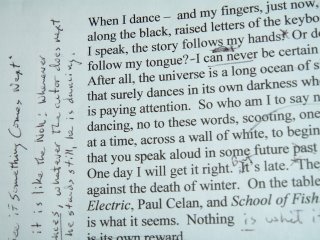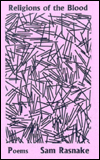embracing the impossibility…
from my anthology of (a)merican poems that should be read
Jane Kenyon
Not Writing
A wasp rises to its papery
nest under the eaves
where it daubs
at the gray shape,
but seems unable
to enter its own house.
*
There are so many Jane Kenyon poems that connect with me – “Mosaic of the Nativity: Serbia, Winter 1993” or “Waking in January Before Dawn” or “Letter to Alice” – but “Not Writing” is the one I’ve settled into in recent years.
From my first read of the poem, I was compelled to enlarge the title. Yes – this is a poem about writing and the inability to write – but Kenyon’s intent may be to move the reader into the world of the everyday. The title could easily imply that the poem's focus is not writing but something, anything, other than writing – Life.
Because of Kenyon’s struggles with depression, I can’t help but read the poem as directing its energies toward the emotional or the psychological. A person spends his life building a world that he can’t successfully enter – a plan that’s never fulfilled – a journey never completed. The Western mind has trouble with this concept – We should find what we seek – We should reach the road’s destination. The Eastern view, on the other hand, embraces the impossibility of it all. I may spend my entire life trying to write the poem that’s in my head – and never finish it, never find the words. And that’s fine. I keep my pen moving over paper anyway – I’m under the eaves daubing the gray shape. That’s the way it should be.
“Seems” looms as a large possibility in this brief poem – a point of hope. With this idea, Kenyon moves beyond the wasp’s rising to live on its house – never living inside – to the possibility of an individual who could enter that other world. What does live inside the house – and here read grow – is the future, the creation, the child, the poetry. Stories that come to mind: Alice in Wonderland, Gulliver’s Travels, Orphée, 2001: A Space Odyssey ...
When my own writing stumbles, this poem comes to mind – the hard-working wasp, focused on the life inside that house. Another point of fascination is the fragile nature of the house: “papery / nest under the eaves”. Kenyon’s choice of “daubs” as the action descriptive is ingenious because of its implications: awkward, chaotic, muddled. Very life-like. When my life stumbles, this is a poem to turn to.
A world in a tiny package.









6 comments:
Jane Kenyon is (was)(is) such a saving grace.
Agreed. Kenyon rules. And why? For one thing, her substance is not incidental, it's just as important as her form. And two, she works from a personal belief system in a personal god. Her poems are informed by eternal values.
A professor friend of mine got to compare 16 or 18 different drafts of "Having it Out with Melancholy" for his book. So she obviously thought, that whatever the inspiration, a poem needs some fine-tuning over time.
But why should I identify with a manic-depressive Christian poet? ;-)}
She's one of my favorites. Thanks for posting this, Sam.
Good pick, Sam.
I'm glad I have access to this anthology you're compiling, Sam. I wish it was a real live book I could hold in my hand, that I could read and reread. Not just the poems, but your commentary, too.
I swear, I'd dog ear every page.
This Kenyon is like the haikus below....so small, so compressed, yet so huge, so whole.
sam, i rally enjoy reading your poetry picks, and your comments. this one by kenyon is no exception. she can say a lot in a few sentences, build whole worlds. there is so, so much beneath the surface.
m
Post a Comment